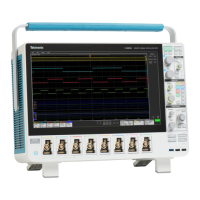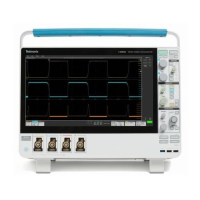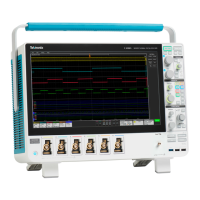Commands listed in alphabetical order
Group
Acquisition
Syntax
ACQuire:MODe {SAMple|PEAKdetect|HIRes| AVErage|ENVelope }
ACQuire:MODe?
Related Commands
ACQuire:NUMAVg, CURVe
Arguments
SAMple specifies that the displayed data point value is the first sampled value
that is taken during the acquisition interval. In sample m ode, all waveform data
has 8 bits of precision. You can request 16 bit data with a CURVe query but the
lower-order 8 bits of data will be zero.
SAMple is the default mode.
PEAKdetect specifies the display of high-low range of the samples taken from a
single waveform acquisition. The high-low range is displayed as a vertical column
that extends from the highest to the lowest value sampled during the acquisition
interval.
PEAKdetect mode can reveal the presence of aliasing or narrow spikes.
HIRes specifies Hi Res mode where the d isplayed data point value is the
average of all the samples taken d uring the acquisition interval. This is a form
of averaging, where the average comes from a single waveform acquisition. The
number of samples taken during the acquis ition interval determines the number of
data values that compose the average.
AVErage specifies averaging mode, in which the resulting waveform shows a n
average of
SAMple data points from several separate waveform acquisitions. The
instrument processes the number of waveforms you specify into the acquired
waveform, creating a running exponential average of the input signal. The number
of waveform acquisitions that go into making up the average waveform is set or
queried using the ACQuire:NUMAVg command.
ENVelope spe cifies envelope mode, where the resulting waveform shows the
PEAKdetect range of data points from s everal separate waveform acquisitions.
The number of waveform acquisitions that go into making up the envelope
waveform is set or queried using the ACQuire:NUMAVg command.
The instrument acquires data after each trigger event using Sample mode; it then
determines the pix map location of each sample point and acc umulates it with
stored data from previous acquisitions.
A Pix map is a two dimensional array. The value at each point in the array is
a counter that reflects the hit intensity. Infinite and noninfinite persist display
modes affect how pix maps are accumulated. Zoom, Math, FastAcq, FastFrame,
XY, Roll, and Interpolated Time (IT) Sampling Mode are conflicting features to
WFMDB acqMode. Turning on one of them generally turns the other one off.
Selection of some standard masks (for example, eye masks, which require option
MTM) changes the acquisition mode to WFMDB.
MSO54, MSO56, MSO58, MSO58LP Programmer 2-95

